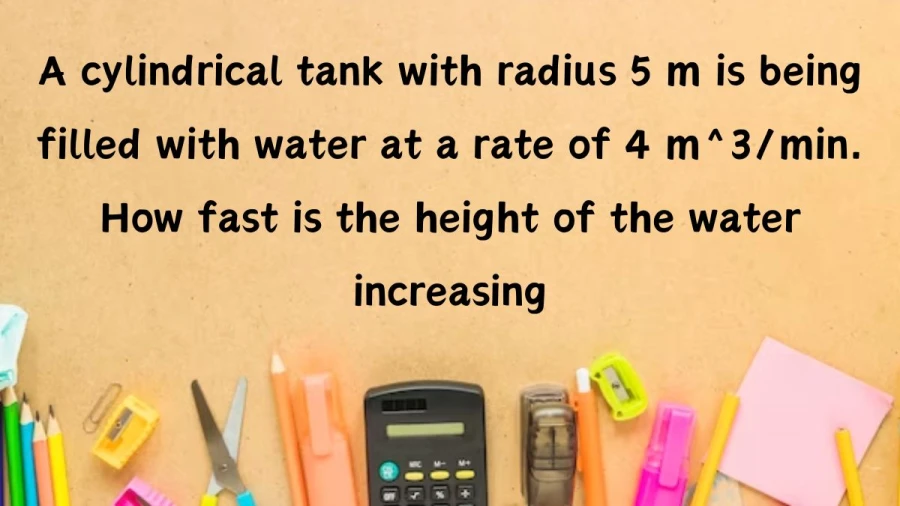If you happen to be viewing the article A cylindrical tank with radius 5 m is being filled with water at a rate of 4 m^3/min. How fast is the height of the water increasing? ? on the website Math Hello Kitty, there are a couple of convenient ways for you to navigate through the content. You have the option to simply scroll down and leisurely read each section at your own pace. Alternatively, if you’re in a rush or looking for specific information, you can swiftly click on the table of contents provided. This will instantly direct you to the exact section that contains the information you need most urgently.
A cylindrical tank with radius 5 m is being filled with water at a rate of 4 m^3/min. How fast is the height of the water increasing?
The rate at which the height of the water is increasing is approximately 0.0509 m/min.
Given:
- Radius of the cylinder, r = 5 m
- Rate at which water is being filled, dV/dt = 4 m^3/min
Using the formula for the volume of a cylinder: V = πr^2h
Differentiating this formula with respect to time t to get the rate of change of volume: dV/dt = πr^2 * dh/dt
Given dV/dt = 4 m^3/min and r = 5 m, we can solve for dh/dt:
4 = π(5)^2 * dh/dt 4 = 25π * dh/dt
dh/dt = 4 / 25π
Now, evaluating this expression: dh/dt ≈ 0.0509 m/min
So, the rate at which the height of the water is increasing is approximately 0.0509 m/min.
How to Calculate the Volume of a Cylinder?
To calculate the volume of a cylinder, you can use the formula:
Volume = π * r^2 * h
Where:
- π (pi) is a constant approximately equal to 3.14159
- r is the radius of the cylinder’s base
- h is the height of the cylinder
Here’s a step-by-step guide on how to calculate the volume of a cylinder:
-
Measure the radius (r) of the cylinder’s base. The radius is the distance from the center of the circle (base) to its edge. If you have the diameter (the distance across the circle), you can divide it by 2 to get the radius.
-
Measure the height (h) of the cylinder. This is the distance between the two bases of the cylinder.
-
Plug the values of the radius (r) and height (h) into the formula: Volume = π * r^2 * h.
-
Calculate the volume using the formula. First, square the radius (r^2), then multiply it by π (pi), and finally multiply the result by the height (h).
-
After performing the calculations, you’ll have the volume of the cylinder in cubic units (cubic inches, cubic centimeters, etc.), depending on the units used for radius and height.
-
Remember to include the appropriate units in your final answer.
Here’s an example: Let’s say we have a cylinder with a radius of 5 cm and a height of 10 cm.
Volume = π * (5 cm)^2 * 10 cm Volume = π * 25 cm^2 * 10 cm Volume = π * 250 cm^3 ≈ 785.4 cm^3
So, the volume of the cylinder is approximately 785.4 cubic centimeters.
Thank you so much for taking the time to read the article titled A cylindrical tank with radius 5 m is being filled with water at a rate of 4 m^3/min. How fast is the height of the water increasing? written by Math Hello Kitty. Your support means a lot to us! We are glad that you found this article useful. If you have any feedback or thoughts, we would love to hear from you. Don’t forget to leave a comment and review on our website to help introduce it to others. Once again, we sincerely appreciate your support and thank you for being a valued reader!
Source: Math Hello Kitty
Categories: Math

